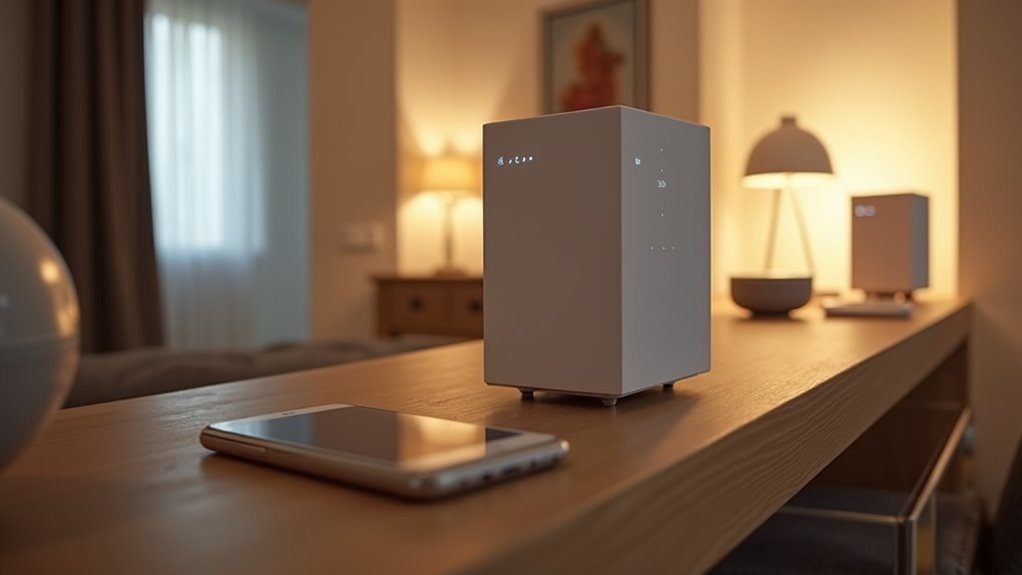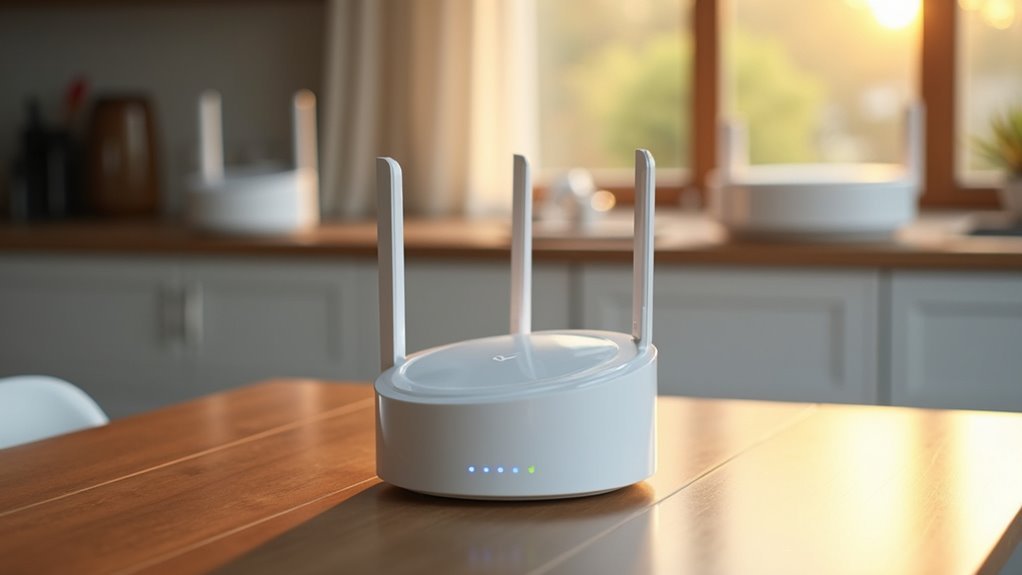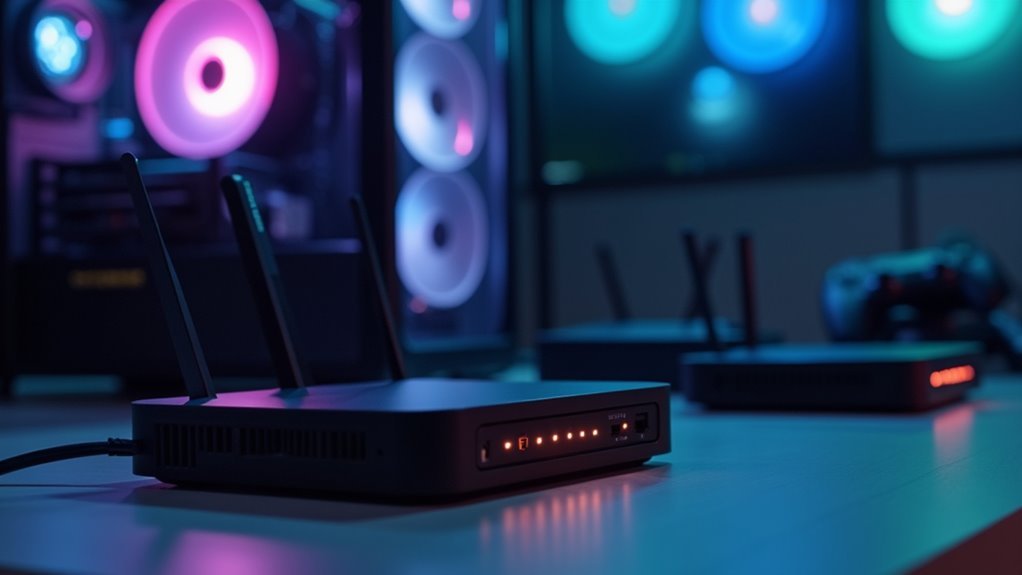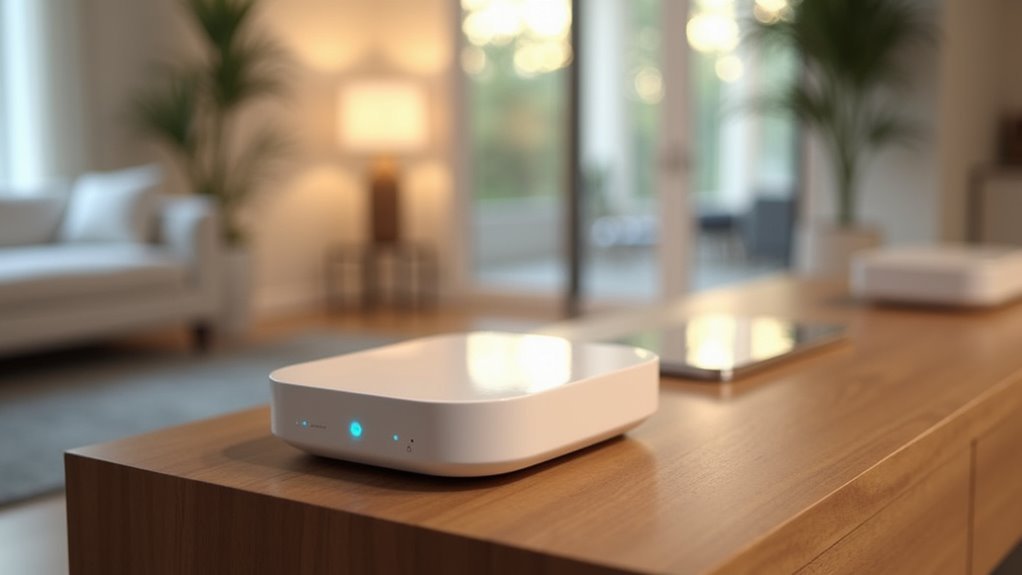You’re probably wondering which mesh WiFi system can truly handle your smart home’s demands without breaking your budget or overwhelming your technical skills. With dozens of options flooding the market—from budget-friendly dual-band networks to premium tri-band powerhouses—choosing the right system isn’t just about speed anymore. It’s about finding that sweet spot where performance, coverage, and future-proofing align with your specific household needs, and the answer might surprise you.
Understanding Mesh WiFi Technology for Smart Homes

While traditional routers struggle to deliver consistent coverage throughout larger homes, mesh Wi-Fi systems revolutionize your home network by creating a unified wireless blanket that reaches every corner.
These interconnected nodes eliminate dead zones while maintaining seamless connectivity as you move throughout your space.
With Wi-Fi 6 technology, you’ll experience notably faster high-speed internet performance, especially when multiple devices connect simultaneously.
Your mesh system handles streaming multiple 4K videos without interruption while supporting various smart home devices through built-in protocols like Zigbee and Thread.
Management becomes effortless through dedicated smartphone apps that provide extensive network security monitoring, device connection oversight, and robust parental controls.
This intelligent approach guarantees your modern home stays connected, secure, and optimized for today’s demanding digital lifestyle.
Top Mesh WiFi Systems Powering Modern Households
You’ll find today’s mesh WiFi market offers compelling options across every price range and performance level.
Whether you’re seeking the best overall value, working within a tight budget, or need maximum speed for gaming and smart home automation, there’s a system designed for your specific needs.
Let’s examine the standout performers in each category to help you choose the right mesh system for your modern household.
Best Overall Performance Winners
When choosing a mesh WiFi system for your modern home, performance should be your top priority since it directly impacts everything from streaming quality to smart device connectivity.
The best overall performance winners deliver exceptional coverage, speed, and reliability across different price points.
The standout mesh routers include:
- Eero 6 Plus – Best overall choice with Wi-Fi 6 performance covering 4,500 square feet for $225
- Asus ROG Rapture GT6 – Fastest speeds averaging 809 Mbps downloads, perfect for demanding users at $400
- TP-Link Deco W7200 – Top budget mesh option offering reliable tri-band Wi-Fi 6 for just $108
- TP-Link Deco XE75 – Excellent Wi-Fi 6E entry point at $170 for next-gen connectivity
These systems prove you don’t need to compromise on overall performance regardless of your budget.
Budget-Friendly Mesh Options
Budget-conscious homeowners don’t need to sacrifice reliable WiFi coverage when upgrading to a mesh system. Several budget-friendly options deliver solid performance without breaking the bank.
The TP-Link Deco W7200 offers exceptional value at $108 for a two-pack, providing tri-band Wi-Fi 6 technology that handles multiple devices efficiently. For even greater coverage, the Netgear Orbi AC1200 three-pack costs just $129, making it perfect for moderate internet needs.
The Vilo mesh router takes affordability further at around $40 per device, though speeds may be slower than premium models. The TP-Link Deco S4 at $100 excels for homes with 500 Mbps or slower connections.
Choosing simpler mesh systems without advanced features considerably reduces costs while still enhancing your home’s wireless coverage effectively.
Gaming and Smart Homes
Modern gaming and smart home environments demand mesh systems that can handle intensive bandwidth requirements and multiple simultaneous connections.
You’ll need a gaming router that delivers consistent performance across your entire home while supporting numerous smart devices simultaneously.
For peak performance, consider these top-tier mesh networking solutions:
- Asus ROG Rapture GT6 – Delivers 809 Mbps fast download speeds, perfect for competitive gaming
- TP-Link Deco BE63 – Features Wi-Fi 7 mesh technology for future-proofing your network
- Eero 6 Plus – Supports Wi-Fi 6 with reliable coverage up to 4,500 square feet
- Eero Max 7 – Includes built-in Zigbee and Thread radios for seamless smart device integration
These systems maintain strong signal strength throughout your home, ensuring lag-free gaming and responsive smart home automation.
Wifi 6 Vs Wifi 7 Mesh Networks for Connected Living
How do you choose between Wi-Fi 6 and Wi-Fi 7 mesh networks when planning your connected home setup?
Wi-Fi 6 mesh networks like the Eero 6 Plus deliver solid performance with speeds up to 940 Mbps, efficiently managing multiple connected devices through OFDMA and MU-MIMO technologies.
These systems cover up to 4,500 square feet, making them ideal for most smart homes.
Wi-Fi 7 mesh systems such as the Asus ZenWiFi BQ16 Pro offer multi-gigabit speeds and enhanced features like Multi-Link Operation for reduced latency.
They’re designed for broader coverage and support more concurrent users without lag.
If you want to future-proof your network and support emerging bandwidth-heavy applications, upgrading to Wi-Fi 7 guarantees your smart home can handle tomorrow’s connected devices and technologies.
Budget-Friendly Mesh Solutions That Deliver Performance

While Wi-Fi 7 systems represent the cutting edge, you don’t need to spend premium prices to get excellent mesh performance for your home. Several budget-friendly mesh options deliver reliable connectivity without breaking the bank.
Consider these affordable solutions that punch above their weight:
- TP-Link Deco W7200 – This tri-band Wi-Fi 6 system costs just $108 for a two-pack, offering easy setup and solid performance for larger homes.
- Netgear Orbi AC1200 – At $129 for three units, it provides strong value and reliable coverage for budget-conscious users.
- Vilo mesh router – Around $40 per device makes it extremely affordable, though speeds may be slower than premium alternatives.
- TP-Link Deco S4 – Perfect for homes with 500 Mbps or slower connections, delivering steady coverage at $100.
Skip Wi-Fi 6E features if you have slower internet speeds to maximize savings.
Premium Mesh Systems for Large Homes and Heavy Usage
Powerhouse mesh systems transform large homes and demanding households into seamlessly connected environments.
Premium mesh systems like the Asus ZenWiFi BQ16 Pro ($949.99) leverage Wi-Fi 7 technology to deliver exceptional coverage for heavy internet usage scenarios. The TP-Link Deco BE63 ($300) excels at managing numerous smart devices simultaneously, while the Netgear Orbi RBKE963 ($1,299) provides extensive coverage for very large homes requiring high-speed connections.
Gaming-focused options like the Asus ROG Rapture GT6 achieve remarkable 809 Mbps download speeds, perfect for 4K streaming and competitive gaming.
These systems feature multiple Ethernet ports, advanced security protocols, and user-friendly apps that simplify network management. You’ll appreciate their ability to maintain consistent performance across demanding applications while providing reliable connectivity throughout expansive properties.
Gaming-Optimized Mesh Networks for Entertainment Spaces

Why settle for lag and buffering when gaming-optimized mesh networks can transform your entertainment space into a high-performance arena?
Systems like the Asus ROG Rapture GT6 deliver impressive 809 Mbps download speeds, ensuring your gaming sessions stay smooth and responsive.
These networks utilize tri-band technology with a dedicated 5GHz backhaul band, guaranteeing uninterrupted bandwidth even when your household’s streaming multiple devices simultaneously.
Here’s what makes them essential for serious gamers:
- Quality of Service (QoS) settings prioritize gaming traffic over other network activities
- Wi-Fi 6 support handles multiple smart home devices without compromising performance
- Customizable RGB lighting adds aesthetic appeal to your gaming setup
- Dedicated gaming features optimize low-latency experiences
You’ll experience seamless gameplay while other family members stream, work, and use connected devices throughout your home.
Smart Home Integration Features in Modern Mesh Systems
As smart home ecosystems continue expanding throughout modern households, today’s mesh WiFi systems have evolved far beyond simple internet connectivity to become the central nervous system of your connected lifestyle.
Modern mesh systems now integrate built-in Zigbee and Thread radios, enabling direct communication with your smart home devices without requiring separate hubs.
The TP-Link Deco XE75’s Wi-Fi 6E technology delivers faster connections and reduced latency for bandwidth-intensive devices, while systems like the Asus ZenWiFi BQ16 Pro accommodate massive device loads without performance drops.
You’ll benefit from dedicated management apps that streamline smart home integration, monitor network activity, and configure parental controls.
These unified platforms transform complex smart home management into intuitive, centralized control.
Coverage Area and Node Placement Strategies
Where you position your mesh nodes determines whether you’ll enjoy blazing-fast connectivity throughout your home or struggle with frustrating dead zones in critical areas.
Modern mesh systems can cover up to 4,500 square feet, but achieving maximum coverage requires strategic node placement.
Strategic node placement is the difference between seamless whole-home coverage and frustrating connectivity gaps in your mesh network.
- Central positioning: Place nodes in central locations to maximize signal distribution and minimize obstructions.
- Multi-floor coverage: Position nodes on different levels to eliminate dead zones on upper or lower floors.
- Additional nodes: Add extra nodes in larger homes or areas with thick walls to enhance connection stability.
- User-friendly apps: Utilize system apps like TP-Link Deco’s visualization tools to identify ideal placement locations.
Smart node placement transforms your coverage area from patchy connectivity into a seamless network experience.
Speed Performance Testing Results Across Leading Brands
Perfect node placement sets the foundation for ideal performance, but the real test comes when you examine how different mesh systems actually deliver on their speed promises.
Speed performance testing results reveal significant differences between leading brands. The Asus ROG Rapture GT6 emerged as the fastest mesh router, averaging 809 Mbps in testing environments with Wi-Fi 6 technology.
However, maintaining consistent speeds across your coverage range varies dramatically by system. The Eero 6 Plus delivers solid Wi-Fi 6 performance within 4,500 square feet, while the standard Eero 6 showed concerning speed drop-offs at distance.
Budget options like the TP-Link Deco W7200 surprised testers with reliable performance, proving you don’t always need premium pricing for dependable mesh router functionality throughout your home.
Security Features and Privacy Controls in Mesh Networks
When you’re setting up a mesh network, you’ll find that today’s systems pack serious security punch with built-in protection software that actively guards against malware and cyber threats.
You can take control of your family’s internet experience through extensive parental controls that let you filter content, pause devices, and manage screen time with just a few taps.
Your network’s privacy settings give you granular control over who accesses your connection and how your data flows through the system.
Built-in Security Software
As cyber threats continue to evolve, mesh WiFi systems have responded by integrating extensive security software directly into their hardware. This built-in security software provides thorough protection that goes beyond basic network encryption, offering multiple layers of defense for your connected devices.
Modern mesh systems like the eero Pro 6E include robust malware protection that actively shields your network from malicious attacks.
You’ll find these essential security features in today’s advanced mesh networks:
- Real-time monitoring of all connected devices with threat detection capabilities
- Parental controls featuring age-based website filters and device-specific access management
- Automatic firmware updates that protect against the latest vulnerabilities
- Individual user profiles with customized security alerts and adaptive protection measures
These integrated solutions eliminate the need for separate security subscriptions while maintaining enterprise-level protection.
Parental Control Options
How effectively can you monitor and control your children’s internet access without constantly hovering over their devices? Modern mesh systems deliver extensive integrated parental controls that transform home network management. You’ll find age-based content filtering across leading brands, automatically blocking inappropriate websites based on your child’s developmental stage.
| Feature | Capability |
|---|---|
| Device Pausing | Instantly halt internet access for specific devices |
| Time Limits | Set daily/weekly usage restrictions |
| Real-time Monitoring | Track which devices are online currently |
| Content Filtering | Block websites by category or age group |
| Mobile Apps | Manage all settings remotely via smartphone |
These parental controls integrate seamlessly with existing security features, including malware protection and encryption. You can pause individual devices during homework time, monitor usage patterns, and guarantee safe browsing—all through dedicated mobile applications that provide instant network oversight.
Network Privacy Settings
While parental controls provide essential family protection, your mesh network’s broader security architecture determines whether your personal data remains truly private.
Modern mesh systems deliver extensive network privacy settings that go far beyond basic parental controls.
Your privacy protection includes:
- WPA3 encryption – Advanced security protocols that make unauthorized network access nearly impossible
- Real-time threat monitoring – Built-in malware scanning actively identifies and blocks suspicious activities before they compromise your devices
- Automatic firmware updates – Essential security patches install seamlessly without manual intervention, closing vulnerabilities immediately
- Device management dashboards – Mobile apps provide complete visibility into connected devices and suspicious connection attempts
These integrated security features work together, creating multiple layers of protection that safeguard your personal information from external threats while maintaining seamless connectivity throughout your home.
Setup and Management Apps for DIY Installation
Gone are the days when setting up a home network required extensive technical knowledge or professional installation. Modern mesh systems come with dedicated smartphone apps that make setup and management incredibly straightforward. These management apps provide guided installation processes, walking you through each step regardless of your technical expertise.
You’ll enjoy real-time monitoring capabilities that display connected devices, IP addresses, and bandwidth usage. The apps offer advanced features like parental controls and device prioritization for peak performance. Many systems, including TP-Link and Eero, handle firmware updates automatically through their apps.
| Feature | Benefit |
|---|---|
| Guided Installation | Simplified setup process |
| Real-time Monitoring | Track device usage |
| Parental Controls | Manage family internet access |
| Automatic Updates | Enhanced security maintenance |
Tri-Band Vs Dual-Band Mesh Architecture Benefits
You’ll notice significant differences in how tri-band and dual-band mesh systems distribute bandwidth across your network.
Tri-band systems dedicate an entire 5GHz band exclusively for node-to-node communication, preventing your devices from competing with backhaul traffic for available bandwidth.
This architecture becomes essential when you’re running multiple high-demand activities simultaneously, as dual-band systems often struggle under heavy loads that can bottleneck your entire network.
Bandwidth Distribution Advantages
When you’re choosing between dual-band and tri-band mesh systems, understanding how each architecture handles bandwidth distribution can make the difference between seamless connectivity and frustrating slowdowns.
Tri-band systems excel at managing traffic through their additional 5GHz band, creating dedicated backhaul connections that prevent congestion on your primary device bands. In high-density device environments, this architecture maintains stable connections by distributing load across three frequencies instead of two.
Key bandwidth distribution advantages include:
- Enhanced backhaul performance – Dedicated band for node communication reduces interference
- Superior speed delivery – Systems like Asus ROG Rapture GT6 achieve 809Mbps average download speed in speed tests
- Reduced network congestion – Three bands handle simultaneous device connections more effectively
- Gaming and streaming optimization – Heavy bandwidth activities won’t compromise other connected devices
Dual-band systems work adequately for smaller households but struggle when multiple devices compete for the same two frequency bands.
Performance Under Load
While dual-band systems can handle moderate internet usage effectively, tri-band mesh networks demonstrate their true superiority when your household pushes bandwidth to its limits.
Performance tests reveal tri-band mesh systems sustaining download speeds exceeding 800 Mbps, while dual-band systems struggle maintaining speeds above 500 Mbps under heavy load.
You’ll notice the difference when multiple 4K streams run simultaneously alongside gaming sessions and video calls.
Dual-band systems experience congestion because they share the same 5GHz band for backhaul and device connections, creating bottlenecks.
Tri-band networks dedicate an entire band for backhaul communication, ensuring high-demand applications receive uninterrupted bandwidth.
This architecture maintains superior signal strength across larger spaces, delivering consistent performance when your connected devices compete for network resources.
Future-Proofing Your Home Network Investment
As technology rapidly evolves, choosing the right mesh system today determines whether you’ll need costly upgrades in just a few years.
Future-proofing your investment requires selecting systems that’ll handle tomorrow’s demands while delivering exceptional performance today.
Consider these essential future-proofing features:
- Wi-Fi 6 and Wi-Fi 6E compatibility guarantees your mesh systems work seamlessly with the latest devices while providing enhanced speeds for modern smart homes.
- Wi-Fi 7 support in systems like the TP-Link Deco BE63 prepares your network for evolving high-speed internet demands.
- Multi-gigabit Ethernet ports accommodate future bandwidth requirements for streaming, gaming, and remote work.
- Advanced security features including malware protection and parental controls safeguard against emerging cyber threats.
Investing wisely now prevents expensive network overhauls as your connected home grows.
Choosing the Right Mesh System for Your Smart Home Needs
You’ll need to balance your smart home’s device compatibility requirements with your available budget when selecting a mesh system.
Consider how many smart devices you’re currently running and plan to add, as systems like the Eero with built-in Zigbee and Thread radios can streamline connectivity for various home automation gadgets.
Your budget will ultimately determine whether you can invest in cutting-edge Wi-Fi 7 systems like the TP-Link Deco BE63 or if you’ll opt for proven Wi-Fi 6 alternatives that still deliver excellent performance.
Smart Device Compatibility
When you’re building a smart home ecosystem, your mesh WiFi system becomes the backbone that connects everything from smart thermostats to security cameras.
Smart device compatibility is essential when selecting the right mesh systems for your home’s connectivity needs.
Modern systems like Eero integrate Zigbee and Thread protocols, ensuring seamless communication between your devices. Wi-Fi 6 support dramatically improves performance when you’re simultaneously streaming 4K content and managing multiple smart gadgets.
Key compatibility features to evaluate:
- Protocol support – Look for Zigbee and Thread integration for enhanced device communication
- Bandwidth management – High-capacity systems handle multiple devices without speed drops
- Dedicated apps – Smartphone applications simplify device management and parental controls
- Future-proofing – Wi-Fi 6E compatibility accommodates growing smart home demands
Choose systems that grow with your expanding smart home ecosystem.
Performance Vs Budget
Finding the perfect mesh WiFi system means balancing your performance needs against your budget constraints. High-end options like the Asus ZenWiFi BQ16 Pro deliver exceptional performance at $949.99, while budget-friendly choices like the TP-Link Deco S4 provide reliable coverage for just $100.
Your internet speeds play an essential role in this decision—if you’ve got 500 Mbps or less, budget systems often outperform pricier alternatives. Consider how many devices you’ll connect and your usage patterns.
Tri-band systems like the Asus ROG Rapture GT6 excel with multiple simultaneous connections but cost around $400. For smaller homes, dual-band mesh systems like the Eero 6+ offer solid performance at $104.99, making them ideal for budget-conscious households.
Frequently Asked Questions
What Is the Best Mesh Wifi System for Large Homes?
You’ll want the Eero 6 Plus for the best overall performance in large homes. It covers 4,500 square feet with Wi-Fi 6 technology for $225, delivering excellent speed and reliability throughout your space.
What Is a Major Disadvantage of a Mesh Network?
You’ll face higher upfront costs since you must purchase multiple nodes instead of one traditional router. Additionally, you’ll experience increased electricity consumption as each node operates as its own individual router.
What Is the Best Mesh for Home 2025?
You’ll want the Asus ZenWiFi BQ16 Pro for 2025’s best mesh system at $949.99. It delivers extensive coverage and high-speed performance that’ll handle your modern smart home’s demanding connectivity needs perfectly.
Which Is Better Wifi Mesh or Powerline?
You’ll find Wi-Fi mesh systems generally outperform powerline adapters. Mesh networks deliver faster speeds, better coverage, and greater reliability. While powerline’s cheaper, it’s limited by your home’s electrical wiring quality and distance constraints.





Leave a Reply